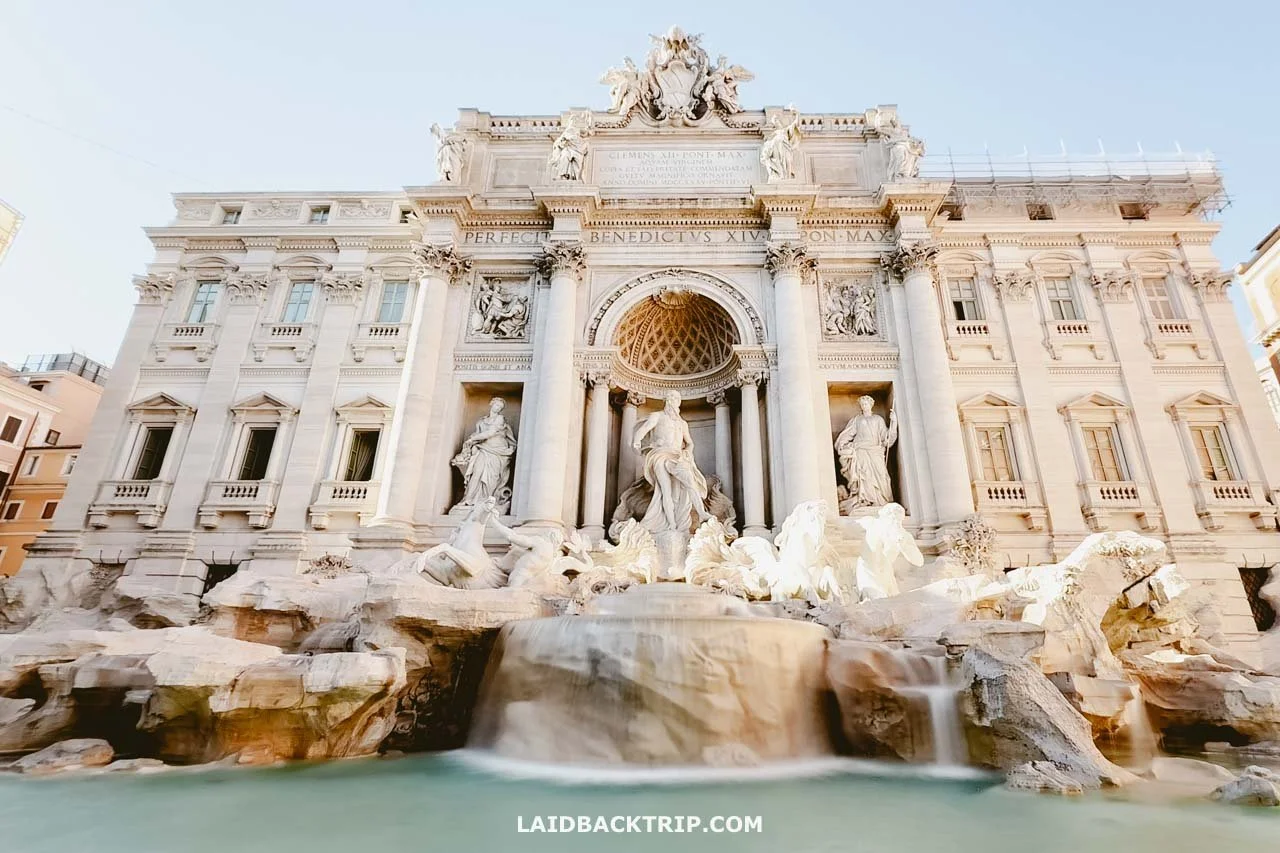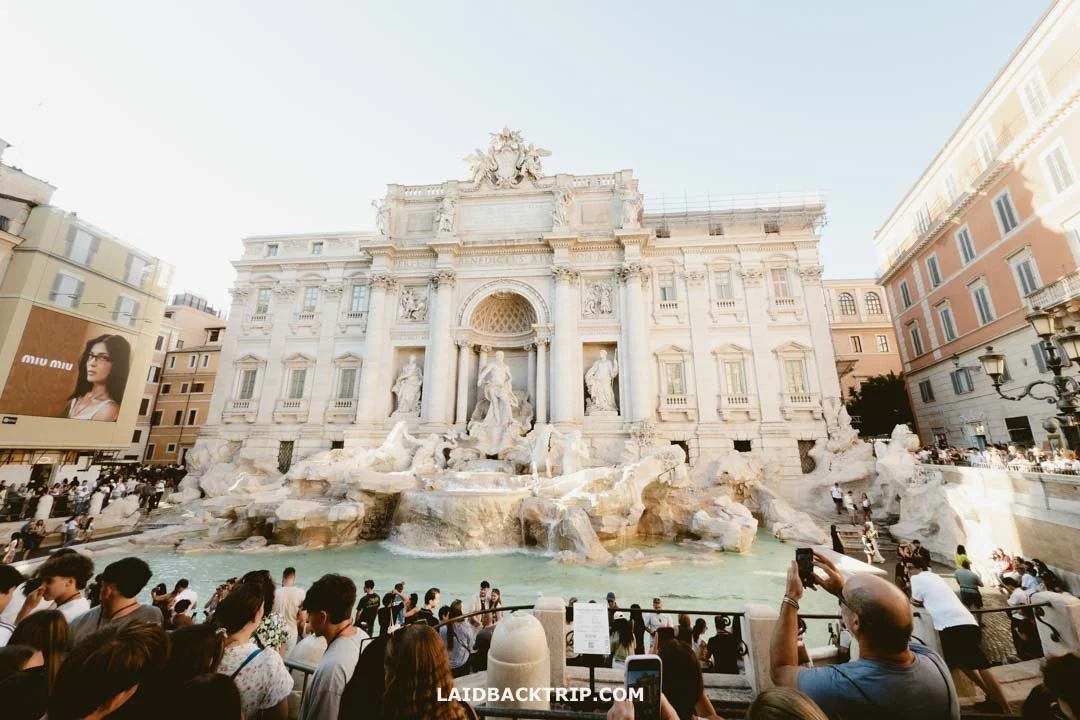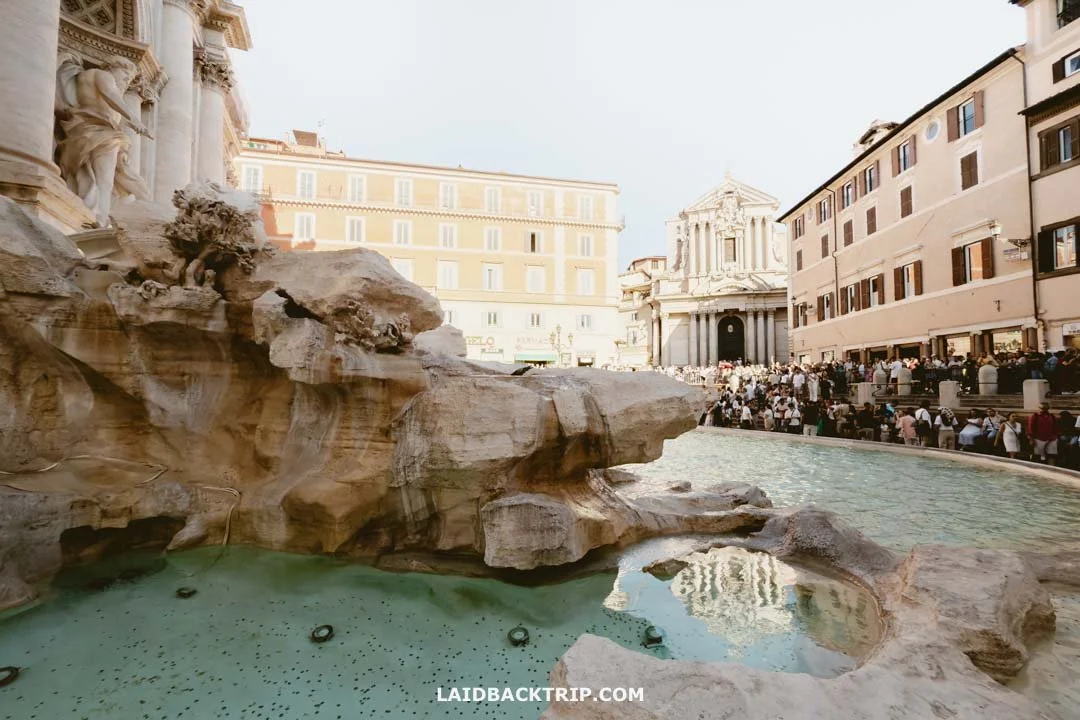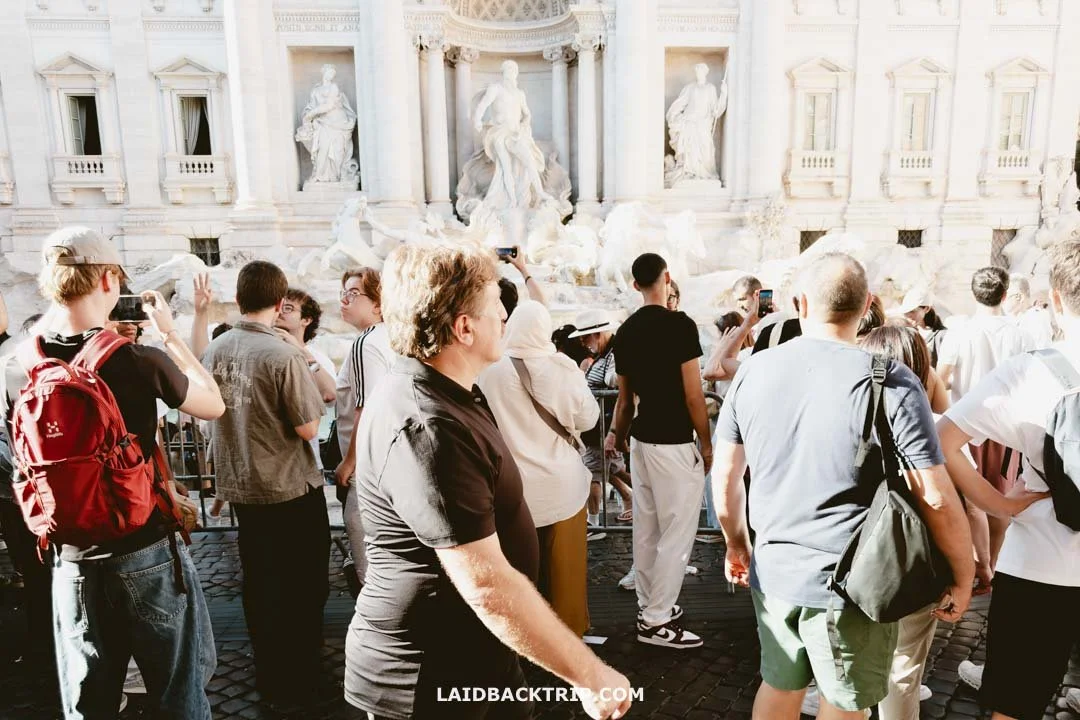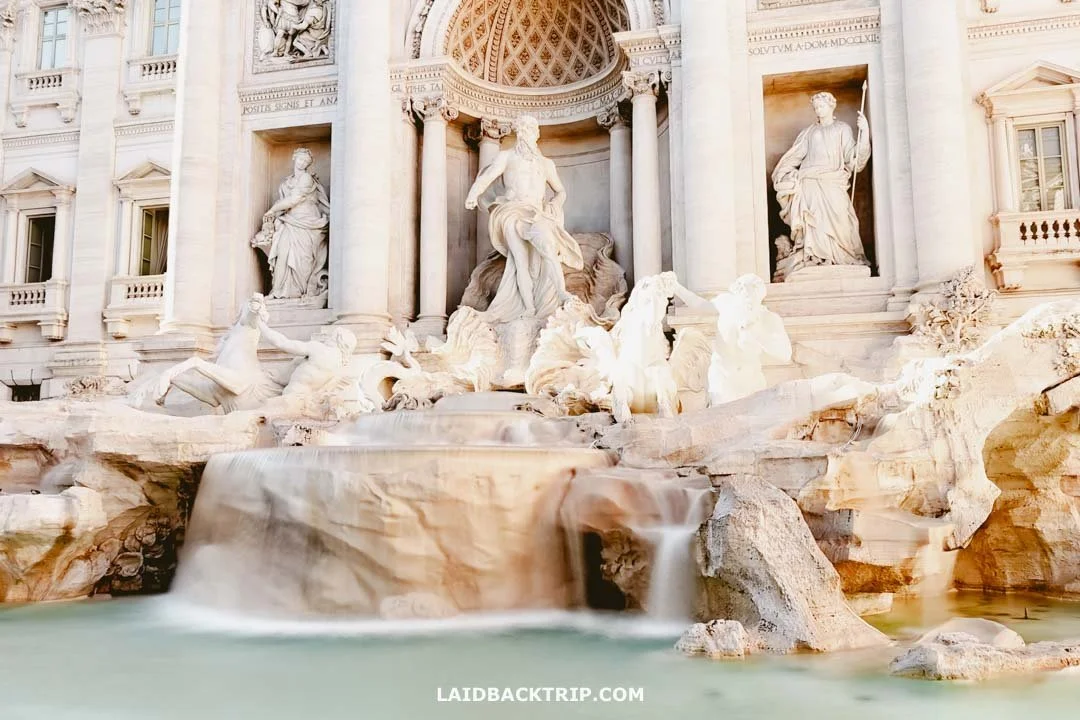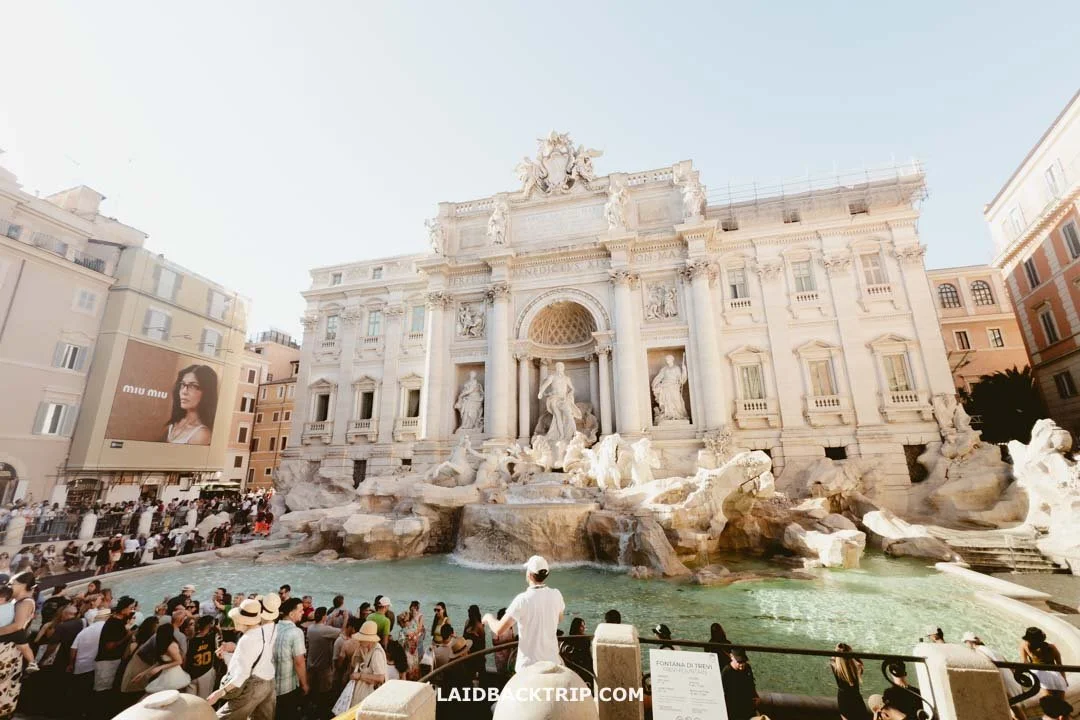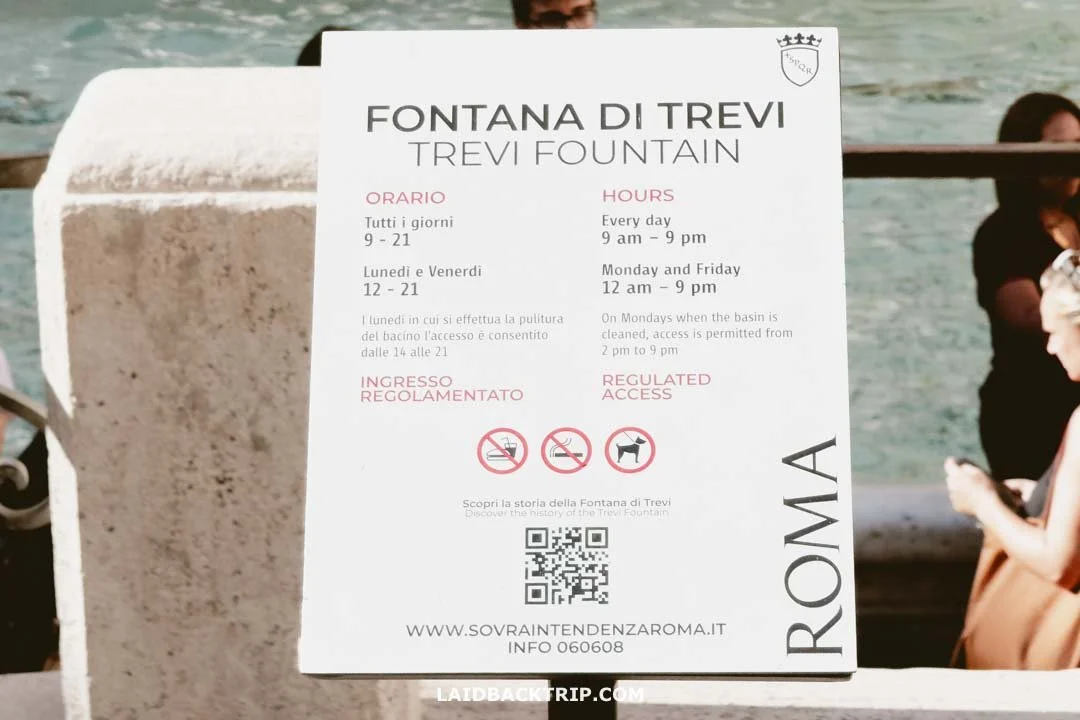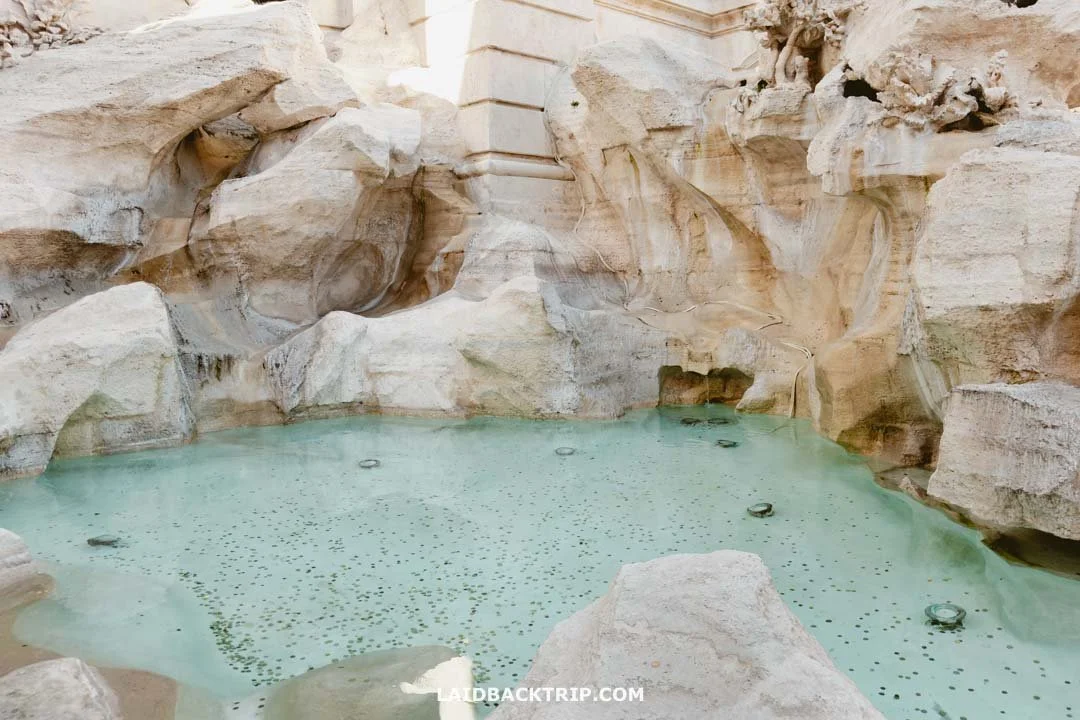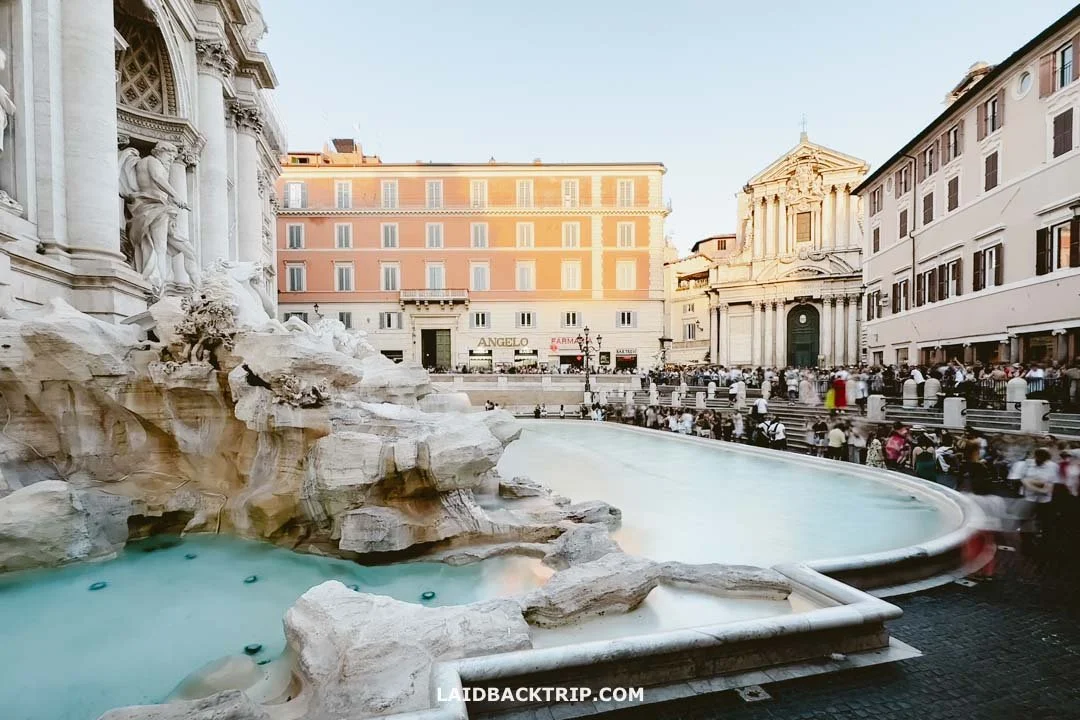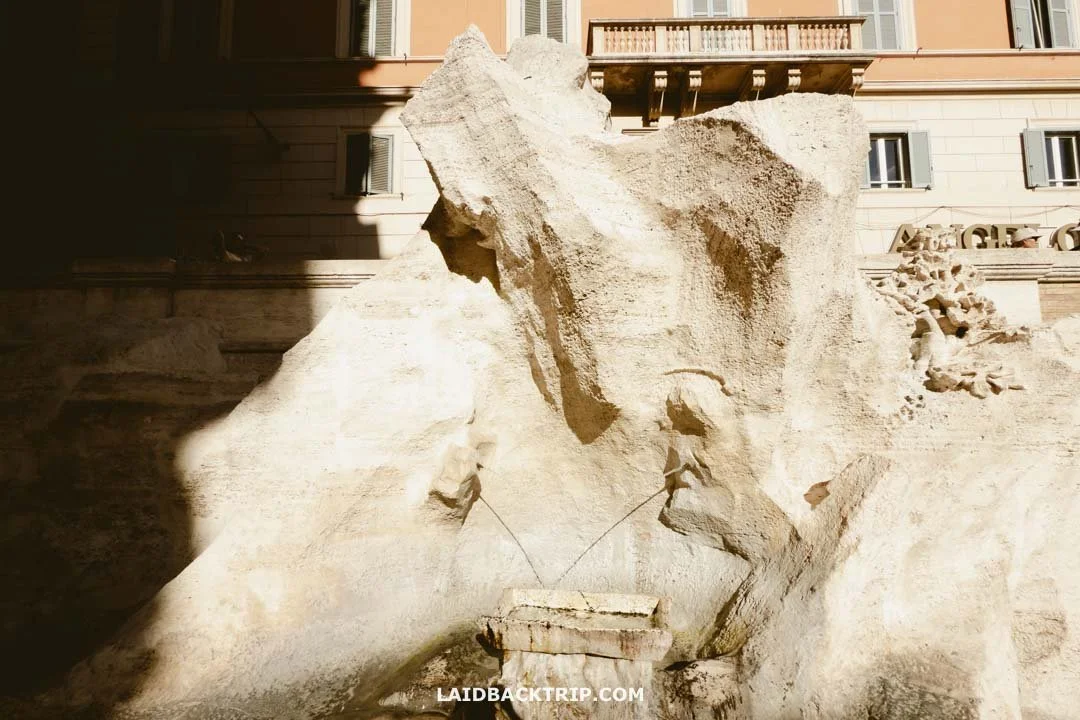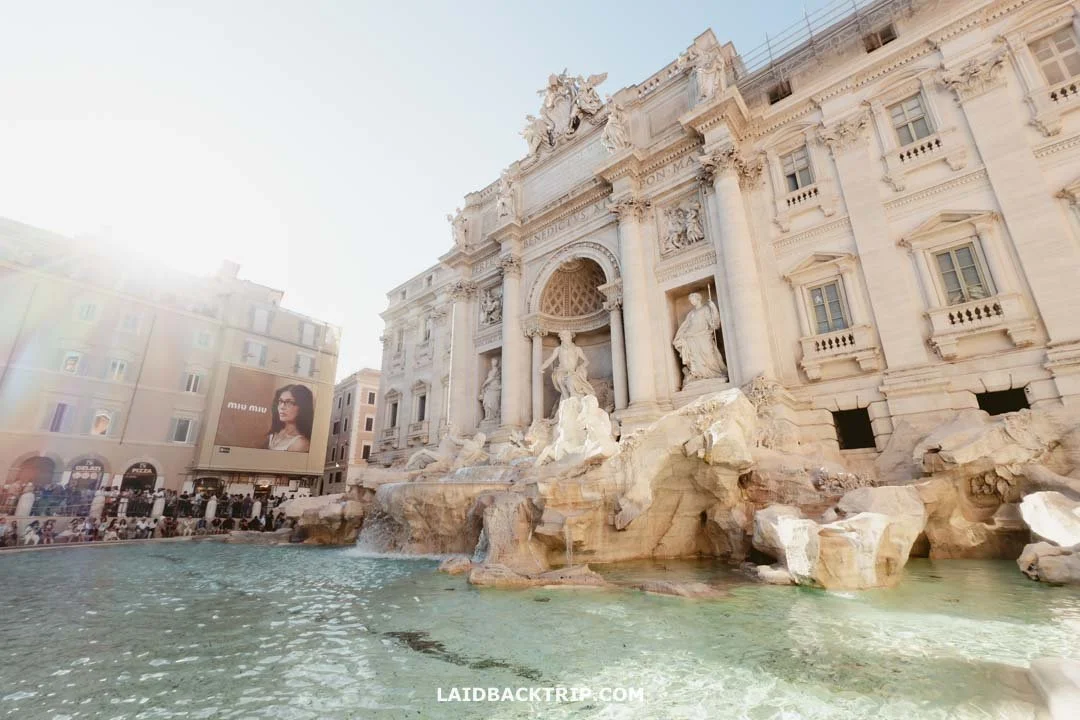How to Visit the Trevi Fountain
There are just a handful places as famous as Trevi Fountain in Rome.
Rome has many fountains, but only one of them is the iconic Trevi Fountain. Here's how we enjoyed it.
The Trevi Fountain is easily one of the most beautiful places in Rome. Since this was Lucie's first time here, she was really excited to see it. Even though we had other plans for our first days in the city, we just couldn't resist and stopped by at the first chance we had. For us, that moment came in the evening after visiting the Vatican Museums and St. Peter's Basilica.
The thing with the Trevi Fountain is that it's famous not just for looking beautiful, but for drawing big crowds, too. Its beauty is a given, but the crowds can definitely impact your visit if you don't expect them or just don't like dealing with busy spots.
The main thing about the crowds is that they changed what it's like to visit Trevi Fountain. It wasn't as calm as I remembered from over twenty years ago, the first time I was here. To be fair, you could say the same for just about any tourist spot now.
Since we were staying in the Centro Storico, we saw the Trevi Fountain more than once, just because this little square was on our way to other places. Still, since it's one of Rome's top sights, we made sure to come here just for the fountain, too. So, this guide is exactly how our visit went.
Trevi Fountain was built in the 18th century.
There Are Always Big Crowds at Trevi Fountain
Trevi Fountain is definitely one of Rome's most visited spots, but the problem is that Piazza di Trevi, where it sits, is actually pretty small, especially considering how many tourists show up every day. Honestly, this beautiful square just wasn't built for these kinds of crowds.
Even though we were staying just 10 minutes away, we never actually got ourselves to go there early in the morning to avoid the crowds and see the Trevi Fountain when it was calmer. Sure, it sounded like a good idea, but it just didn't fit into our plans, and honestly, we simply didn't mind that the square was packed.
In fact, it was one of the few places where we kind of embraced the crowds and just went with it. I'm not saying that we loved weaving through this sea of people, but there was something about it. The whole area around the Trevi Fountain just felt alive.
It's easy to see why Trevi Fountain is so popular.
So, was there actually a way to avoid the crowds at the Trevi Fountain? Well, we were in Rome in September, and the famous sights we managed to see early in the morning, like the Pantheon or Castel Sant'Angelo at around 7 AM, were almost empty. We figured Trevi Fountain would probably be the same.
If you want to avoid waiting in line and just see the Trevi Fountain without people, you have to get there early. In the late summer (meaning September), aiming for about 7 AM will usually do the trick. For the super-busy summer months of June, July, and August, though, you’ll clearly need to show up a little earlier.
From this side view of Trevi Fountain, you can see how small Trevi Square is.
Don't forget the option of seeing the fountain at night. The entire monument is illuminated, but honestly, we still think it’s most beautiful during the day. But honestly, the crowds didn't bother us since we had other priorities.
My favorite moment was when we were moving into another hotel halfway through our stay (since we couldn't find a good one for all eight days in Rome). We decided to walk, and the navigation suggested a route taking us right through the crowded square. The idea of rolling our luggage through the Trevi Fountain crowds was an easy "nope," no matter how wild it sounded.
The small Trevi Square in front of the fountain was incredibly crowded with tourists during the day.
The only thing that really worried us wasn't the crowds themselves, but the chance of pickpockets hiding in them. With such limited space and so many tourists, Trevi Fountain really had that vibe. We pretty much just had our phones and a small daypack with some snacks, water, and a travel wallet tucked away. Since we only brought essentials, it was easy to keep an eye on our stuff.
World Nomads provides travel insurance for travelers to cover their trip essentials, including sports and adventure activities.
SafetyWing is affordable travel insurance for backpackers, long-term travelers, and digital nomads.
Trevi Fountain Is Gorgeous
The Trevi Fountain (Fontana di Trevi) is Rome's stunning Baroque masterpiece, finished in 1762 by Giuseppe Pannini using Nicola Salvi's original plans. It takes over the small Piazza di Trevi and marks the end of the Acqua Vergine, an ancient Roman aqueduct.
No matter the angle, Trevi Fountain looked simply stunning.
At the center stands the powerful figure of Oceanus, led by two Tritons, guiding shell-shaped chariots. The fountain is also known for the tradition of tossing a coin into the water to guarantee a return to Rome. Even if just standing in the square, the mix of crystal clear water, Baroque design, and the massive statue of Oceanus makes the Trevi Fountain one of the most picturesque spots in Rome.
We Had to Wait in Line to Get to the Trevi Fountain
Trevi Fountain got so busy that they had to add entry lines to manage the crowd, but this only applies if you want to get down to the basin for a better photo or to toss a coin. It can seem a bit confusing, so I'll make it as simple as possible.
The fountain sits right on a small square in Rome's center, surrounded by buildings. The whole square is public, so anyone can visit, no matter the time of day or night.
The nice thing was we got to enjoy some really nice views of Trevi Fountain while waiting.
But during the day, it gets packed since every tourist wants a look. That's why the city put a restricted zone around the basin to control how many people are allowed close at once.
Trevi Fountains' Entry Lines Have Opening Hours
While we were waiting in line, we saw a small sign with the Trevi Fountain's hours. Technically, the whole square with the fountain is open 24/7 and doesn't have official opening or closing times, but the entry lines for people going down to the basin do have specific hours.
This sign showed Trevi Fountain's current opening hours.
To help manage the crowds, access to the Trevi Fountain basin is open from 9 AM to 9 PM. The sign also said that on Monday and Friday, the hours are from 12 PM to 9 PM. The tricky part is that on Mondays, they clean the water basin, so access starts at 2 PM. From what we gathered, every other Monday, they do a deeper cleaning (not just picking up coins, but also draining the water), which takes even more time, hence the shorter hours.
There Is No Admission Fee to the Trevi Fountain
Even with the new entry lines making things a bit trickier, we were glad to see the Trevi Fountain was still free to visit, even if I wanted to walk down closer to the fountain.
The views of Trevi Fountain from the square were still really quite great.
We've already seen that some places, like the Roman Forum, have started charging entry fees, so hopefully that won't happen with the Trevi Fountain. If anything changes, though, it would probably be for people who want to get right down to the edge and toss in a coin.
We Didn't Toss Coins into the Trevi Fountain
Tossing a coin into the Trevi Fountain is one of those classic traditions that's supposed to make sure you come back to Rome. But you have to do it the right way. You're supposed to toss the coin with your right hand over your left shoulder, because that's how the wish is meant to work.
We honestly didn't plan ahead for this, so when we finally decided to wait in line, we realized we hadn't brought any coins. We did carry some cash, maybe €50 for emergencies, but not a single coin between us. We didn't skip the toss because we didn't want to take part, so it really just came down to not having any coins at all.
The bottom of the Trevi Fountain basin is usually covered with coins tossed there by tourists.
I had been to Rome over twenty years ago, but I couldn't even remember if I participated in this tradition that time. Since the whole idea is that you'll return if you toss a coin, and here we were again, maybe it worked. Or maybe it's just because Lucie wanted to see the city. Who knows?
They clean out the fountain every week and collect all the coins. We read somewhere it's around €3,500 a week, and all that money goes to charity, which we thought was pretty cool.
There Was Not Much Else to Do at the Trevi Fountain
After about ten minutes of waiting in the sun, we finally got our turn to see the Trevi Fountain up close. The restricted area was still pretty crowded, but it felt calmer than the square above. Once we were down there, there were really only two things to do.
First, we took a proper moment to admire the detailed Baroque statues, Oceanus, the Tritons, and the allegorical figures like Abundance. Then we enjoyed the impressive facade of the Palazzo Poli behind the fountain, with its classic columns and Corinthian pilasters, as well as the turquoise color of the water. The other thing was, of course, the famous coin toss, which we've already mentioned earlier.
Oceanus' statue takes center stage at Trevi Fountain.
Something we found interesting was how the staff at Trevi Fountain didn't just handle the crowds, but they were also in charge of keeping track of everyone's time. When we visited during the restricted hours, they tried to make sure people didn't linger too long. On the busiest days, you might only get five minutes in the area by the water.
The Trevi Fountain is a monumental Baroque masterpiece.
On paper, that sounds like it would make the visit sort of a hassle. But for us, it actually wasn't bad at all. Every so often, staff would call out to remind people if they'd overstayed their welcome, but it never felt like they were being too strict.
The Trevi Fountain and the whole square were beautiful, but not surprisingly, there wasn't much else to do after we finished soaking in the view. You could check out a couple of gelateries (beware or tourist-traps here), browse a few small shops, or maybe step into the Chiesa dei Santi Vincenzo e Anastasio, the little church tucked in the southeast corner.
Trevi Fountain with the Santi Vincenzo e Anastasio a Trevi church in the background.
Our Tip on the Trevi Fountain Tour
Another option was a guided tour that included the Trevi Fountain and the underground of a 2,000-year-old aqueduct, still working today and feeding water to the fountain above, which seemed fascinating, but we didn't have time for it.
We Spend About 30 Minutes at the Trevi Fountain
On the day we decided to wait in line and actually make it down to the basin, we ended up spending about 30 minutes at the Trevi Fountain. Looking back, we pretty much broke the visit into three parts: about 10 minutes in line, another 10 minutes by the edge of the water, and the last 10 minutes just strolling around the square.
On the eastern wall of Trevi Fountain, there was a small fountain with drinking water.
When we think about it, the Trevi Fountain was one of those spots where we didn't hang around for too long. That's just because it's mostly a fountain in a pretty square, and Rome has so many places that kept us busy for much longer (for instance, Baths of Diocletian or Vatican Museums).
Still, since our walks through Rome's historic center took us past here a few more times, we probably spent more total time at Trevi than we'd have expected from a single little square with a fountain.
We Stayed Less Than 10 Minutes Away From the Trevi Fountain
During the first half of our trip, we stayed at Hotel Navona, which was less than a kilometer from the Trevi Fountain. Honestly, staying there meant we could easily explore Rome's most beautiful district and its main sights, Trevi Fountain included.
Later, we switched things up and moved to , also less than a kilometer away. Even though we weren't in the historic center anymore, having the Termini station so close made it super easy for us to take day trips, like heading out to Tivoli or exploring Via Appia Antica.
Hotel Fontana sits right across from the Trevi Fountain.
That said, there are hotels even closer to the Trevi Fountain. Hotel Fontana sits right on Trevi Square, just across from the fountain, so the views can't be beat. A couple of other popular places to stay, like Trevi Beau Boutique Hotel and Relais Fontana Di Trevi Hotel, are right around the corner, too.
We Walked to Trevi Fountain
Getting to the Trevi Fountain means walking, since there isn't really any other way to approach it. Honestly, we barely had to plan our route since we were staying close to Piazza Navona, so getting to Trevi Fountain was just a simple, pleasant 10-minute walk for us.
If you're coming by public transit, the closest metro station is Barberini, about 600 meters away, and the Tritone/Fontana Trevi bus stop on Via del Tritone is even closer at just 200 meters. Barberini is also a stop on pretty much every hop on hop off bus tour.
Is Trevi Fountain Worth Seeing?
For us, Trevi Fountain is absolutely one of Rome's must-see spots. It might be packed with people, but it's so well-known and gorgeous that skipping it just wasn't an option, especially with Lucie getting to experience it for the first time. If you're in Rome for the first time, it's one of those places you just have to see, just like Colosseum or Borghese Gallery.
Even though it was super busy, we really enjoyed visiting Trevi Fountain.
You could try to beat the crowds by showing up earlier in the day, but honestly, the visit is usually pretty quick, so it's not really necessary. The only catch is that when they start limiting access, they keep an eye on how long you're down there, which can feel a little awkward for some. Still, Trevi Fountain is, at the end of the day, a fountain, no matter how breathtaking, and it doesn't take long to take in the view or toss in a coin.
Travel Resources
Here you can find links to all the travel resources we use and which you might find helpful when planning your next holiday.
Accommodation: When looking for accommodation, we usually search hotels via Booking.com or Hostelworld.
Tours: Although we love to travel independently, some places are better to visit with a guided tour.
We prefer GetYourGuide for its easy-to-use interface and solid reputation. Another great alternative is Viator.
Rental Cars: When going on a road trip, we always use Rentalcars.com, a reliable site for booking a rental car in advance.
Flight Tickets: When looking for flight tickets, you can search Skyscanner to find the best price.
Travel Insurance: World Nomads and SafetyWing cover against risks of travel.
